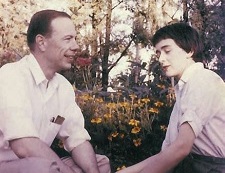|
Nanosyntax
Nanosyntax is an approach to syntax where the terminal nodes of Concrete syntax tree, syntactic parse trees may be reduced to units smaller than a morpheme. Each unit may stand as an irreducible element and not be required to form a further "subtree." Due to its reduction to the smallest terminal possible, the terminals are smaller than morphemes. Therefore, morphemes and words cannot be itemised as a single terminal, and instead are composed by several terminals. As a result, nanosyntax can serve as a solution to phenomena that are inadequately explained by other theories of syntax. Some recent work in theoretical linguistics suggests that the "atoms" of syntax are much smaller than words or morphemes. It then follows that the responsibility of syntax is not limited to ordering "preconstructed" words. Instead, within the framework of nanosyntax, the words are derived entities built into syntax, rather than primitive elements supplied by a lexicon. History Theoretical context Na ... [...More Info...] [...Related Items...] OR: [Wikipedia] [Google] [Baidu] |
Syntax
In linguistics, syntax ( ) is the study of how words and morphemes combine to form larger units such as phrases and sentences. Central concerns of syntax include word order, grammatical relations, hierarchical sentence structure (constituency), agreement, the nature of crosslinguistic variation, and the relationship between form and meaning (semantics). Diverse approaches, such as generative grammar and functional grammar, offer unique perspectives on syntax, reflecting its complexity and centrality to understanding human language. Etymology The word ''syntax'' comes from the ancient Greek word , meaning an orderly or systematic arrangement, which consists of (''syn-'', "together" or "alike"), and (''táxis'', "arrangement"). In Hellenistic Greek, this also specifically developed a use referring to the grammatical order of words, with a slightly altered spelling: . The English term, which first appeared in 1548, is partly borrowed from Latin () and Greek, though the L ... [...More Info...] [...Related Items...] OR: [Wikipedia] [Google] [Baidu] |
Syntax Tree 'mice'
In linguistics, syntax ( ) is the study of how words and morphemes combine to form larger units such as phrases and sentences. Central concerns of syntax include word order, grammatical relations, hierarchical sentence structure (constituency), agreement, the nature of crosslinguistic variation, and the relationship between form and meaning (semantics). Diverse approaches, such as generative grammar and functional grammar, offer unique perspectives on syntax, reflecting its complexity and centrality to understanding human language. Etymology The word ''syntax'' comes from the ancient Greek word , meaning an orderly or systematic arrangement, which consists of (''syn-'', "together" or "alike"), and (''táxis'', "arrangement"). In Hellenistic Greek, this also specifically developed a use referring to the grammatical order of words, with a slightly altered spelling: . The English term, which first appeared in 1548, is partly borrowed from Latin () and Greek, though the Latin t ... [...More Info...] [...Related Items...] OR: [Wikipedia] [Google] [Baidu] |
Tools
A tool is an object that can extend an individual's ability to modify features of the surrounding environment or help them accomplish a particular task. Although many animals use simple tools, only human beings, whose use of stone tools dates back hundreds of millennia, have been observed using tools to make other tools. Early human tools, made of such materials as stone, bone, and wood, were used for the preparation of food, hunting, the manufacture of weapons, and the working of materials to produce clothing and useful artifacts and crafts such as pottery, along with the construction of housing, businesses, infrastructure, and transportation. The development of metalworking made additional types of tools possible. Harnessing energy sources, such as animal power, wind, or steam, allowed increasingly complex tools to produce an even larger range of items, with the Industrial Revolution marking an inflection point in the use of tools. The introduction of widespread automation ... [...More Info...] [...Related Items...] OR: [Wikipedia] [Google] [Baidu] |
Feature (linguistics)
In linguistics, a feature is any characteristic used to classify a phoneme or word. These are often binary or unary conditions which act as constraints in various forms of linguistic analysis. In phonology In phonology, segments are categorized into natural classes on the basis of their distinctive features. Each feature is a quality or characteristic of the natural class, such as voice or manner. A unique combination of features defines a phoneme. Examples of phonemic or distinctive features are: /- voice Advanced tongue root">ATR (binary features) and [ coronal consonant">CORONAL (a unary feature; also a place of articulation">place feature). Surface representations can be expressed as the result of rules acting on the features of the underlying representation. These rules are formulated in terms of transformations on features. In morphology and syntax In morphology (linguistics), morphology and syntax, words are often organized into lexical categories or word ... [...More Info...] [...Related Items...] OR: [Wikipedia] [Google] [Baidu] |
Vocative Case
In grammar, the vocative case (abbreviated ) is a grammatical case which is used for a noun that identifies a person (animal, object, etc.) being addressed or occasionally for the noun modifiers (determiners, adjectives, participles, and numerals) of that noun. A vocative expression is an expression of direct address by which the identity of the party spoken to is set forth expressly within a sentence. For example, in the sentence "I don't know, John," ''John'' is a vocative expression that indicates the party being addressed, as opposed to the sentence "I don't know John", in which "John" is the direct object of the verb "know". Historically, the vocative case was an element of the Indo-European case system and existed in Latin, Sanskrit, and Ancient Greek. In many modern Indo-European languages (English, Spanish, etc.) the vocative case has been absorbed by the nominative, but others still distinguish it, including the Baltic languages, some Celtic languages and most Slavic la ... [...More Info...] [...Related Items...] OR: [Wikipedia] [Google] [Baidu] |
Noun Class
In linguistics, a noun class is a particular category of nouns. A noun may belong to a given class because of the characteristic features of its referent, such as gender, animacy, shape, but such designations are often clearly conventional. Some authors use the term "grammatical gender" as a synonym of "noun class", but others consider these different concepts. Noun classes should not be confused with noun classifiers. Notion There are three main ways by which natural languages categorize nouns into noun classes: * according to similarities in their meaning (semantic criterion); * by grouping them with other nouns that have similar form (morphology); * through an arbitrary convention. Usually, a combination of the three types of criteria is used, though one is more prevalent. Noun classes form a system of grammatical agreement. A noun in a given class may require: * agreement affixes on adjectives, pronouns, numerals, etc. in the same noun phrase, * agreement affixes on the ... [...More Info...] [...Related Items...] OR: [Wikipedia] [Google] [Baidu] |
Nguni Languages
The Nguni languages are a group of Bantu languages spoken in southern Africa (mainly South Africa, Zimbabwe and Eswatini) by the Nguni people. Nguni languages include Xhosa, Tsonga, Ndebele, and Swati. The appellation "Nguni" derives from their ancestor called Mnguni type. ''Ngoni'' (see below) is an older, or a shifted, variant. It is sometimes argued that the use of ''Nguni'' as a generic label suggests a historical monolithic unity of the people in question, where in fact the situation may have been more complex. The linguistic use of the label (referring to a subgrouping of Bantu) is relatively stable. From an English editorial perspective, the articles "a" and "an" are both used with "Nguni", but "a Nguni" is more frequent and more correct especially if "Nguni" is pronounced as it is suggested (). Classification Within a subset of Southern Bantu, the label "Nguni" is used both genetically (in the linguistic sense) and typologically (quite apart from any histor ... [...More Info...] [...Related Items...] OR: [Wikipedia] [Google] [Baidu] |
Lexicon
A lexicon (plural: lexicons, rarely lexica) is the vocabulary of a language or branch of knowledge (such as nautical or medical). In linguistics, a lexicon is a language's inventory of lexemes. The word ''lexicon'' derives from Greek word (), neuter of () meaning 'of or for words'. Linguistic theories generally regard human languages as consisting of two parts: a lexicon, essentially a catalogue of a language's words (its wordstock); and a grammar, a system of rules which allow for the combination of those words into meaningful sentences. The lexicon is also thought to include bound morphemes, which cannot stand alone as words (such as most affixes). In some analyses, compound words and certain classes of idiomatic expressions, collocations and other phrasemes are also considered to be part of the lexicon. Dictionaries are lists of the lexicon, in alphabetical order, of a given language; usually, however, bound morphemes are not included. Size and organization Items ... [...More Info...] [...Related Items...] OR: [Wikipedia] [Google] [Baidu] |
Verb
A verb is a word that generally conveys an action (''bring'', ''read'', ''walk'', ''run'', ''learn''), an occurrence (''happen'', ''become''), or a state of being (''be'', ''exist'', ''stand''). In the usual description of English, the basic form, with or without the particle ''to'', is the infinitive. In many languages, verbs are inflected (modified in form) to encode tense, aspect, mood, and voice. A verb may also agree with the person, gender or number of some of its arguments, such as its subject, or object. In English, three tenses exist: present, to indicate that an action is being carried out; past, to indicate that an action has been done; and future, to indicate that an action will be done, expressed with the auxiliary verb ''will'' or ''shall''. For example: * Lucy ''will go'' to school. ''(action, future)'' *Barack Obama ''became'' the President of the United States in 2009. ''(occurrence, past)'' *Mike Trout ''is'' a center fielder. ''(state of being, present)'' ... [...More Info...] [...Related Items...] OR: [Wikipedia] [Google] [Baidu] |
Goose Structure
A goose (: geese) is a bird of any of several waterfowl species in the family Anatidae. This group comprises the genera '' Anser'' (grey geese and white geese) and ''Branta'' (black geese). Some members of the Tadorninae subfamily (e.g., Egyptian goose, Orinoco goose) are commonly called geese, but are not considered "true geese" taxonomically. More distantly related members of the family Anatidae are swans, most of which are larger than true geese, and ducks, which are smaller. The term "goose" may refer to such bird of either sex, but when paired with "gander", "goose" refers specifically to a female one ("gander" referring to a male). Young birds before fledging are called goslings. The collective noun for a group of geese on the ground is a gaggle; when in flight, they are called a skein, a team, or a wedge; when flying close together, they are called a plump. Etymology The word "goose" is a direct descendant of Proto-Indo-European ''*ǵʰh₂éns''. In Germanic language ... [...More Info...] [...Related Items...] OR: [Wikipedia] [Google] [Baidu] |
Wug Test
Jean Berko Gleason (born 1931) is an American psycholinguist and professor emerita in the Department of Psychological and Brain Sciences at Boston University who has made fundamental contributions to the understanding of language acquisition in children, aphasia, gender differences in language development, and parent–child interactions. Gleason created the Wug Test, in which a child is shown pictures with nonsense names and then prompted to complete statements about them, and used it to demonstrate that even young children possess implicit knowledge of Morphology (linguistics), linguistic morphology. Lise Menn, Menn and Nan Bernstein Ratner, Ratner have written that "Perhaps no innovation other than the invention of the tape recorder has had such an indelible effect on the field of child language research", the "wug" (one of the imaginary creatures Gleason drew in creating the Wug Test) being "so basic to what [psycholinguists] know and do that increasingly it appears in the p ... [...More Info...] [...Related Items...] OR: [Wikipedia] [Google] [Baidu] |




